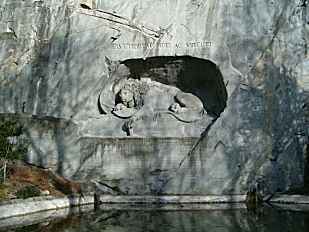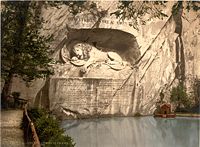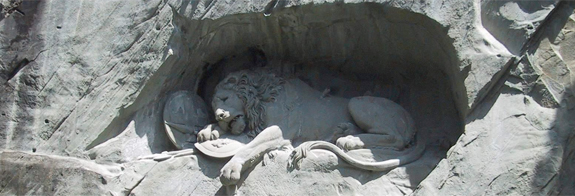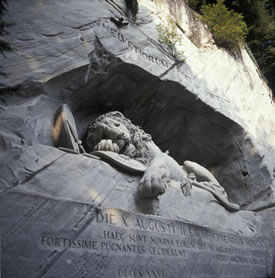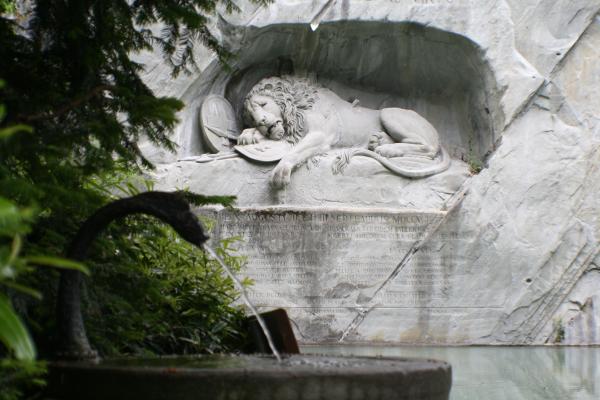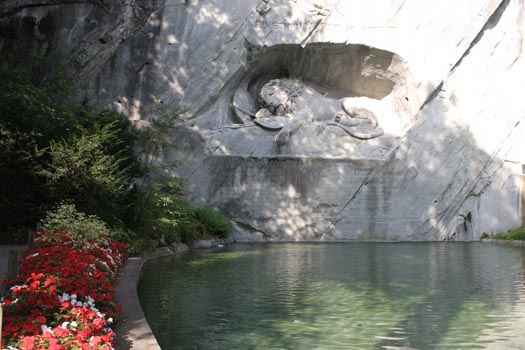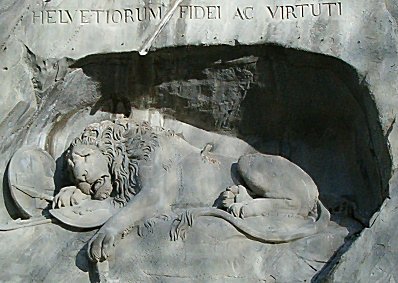 http://www.old-picture.com/europe/Switzerland-Monument-Lucerne-Lion-001.htm
http://www.old-picture.com/europe/Switzerland-Monument-Lucerne-Lion-001.htm
Al llegar a Lucerna, el guía turístico fue poco a poco preparando al
grupo para apreciar el Monumento más importante de Suiza. Viajábamos en
autobús por unos 21 días y ocho países de Europa occidental. Ya nos
conocíamos los componentes del grupo de unos 40 de diversos países,
especialmente de americanos.
Nos llevaron a una plaza mediana y al final una
fuente plana y una montaña de piedra maciza cortada por la mitad. Al
acercarnos se fue definiendo la inmensa escultura de un león acostado.
Se necesitó la descripción del guía para reconocer que al león le
atravesaba el corazón por una lanza partida, que estaba triste y una
lágrima bajaba de su ojo, y mas abajo un listado grande nombres.
La explicación que recuerdo es que para entender el significado del
monumento era necesario saber la
historia de Suiza.
Era el país mas pobre de Europa durante la Edad Media, por sus
escarpadas montañas que dificultaban la agricultura, al tope de los
Alpes con el clima más extremo y sin salida al mar. Eran tan pobres que
se dedicaron a ser los guardaespaldas mercenarios de los reyes y lores
feudales de Europa. Los hijos más altos eran seleccionados para esa
labor. Gran parte de su sueldo lo enviaban a sus familiares en Suiza.
Para el 10 de agosto del 1792, al comienzo de la Revolución francesa,
había un contingente de mercenarios suizos al servicio del Rey Luis XVI
y su familia. La turba anunció asaltar el Palacio de Tuileries.
Todos los soldados franceses se fueron corriendo, sólo quedaron los
mercenarios suizos. El dirigente del contingente suizo los reunió y
dialogaron sobre la situación Si huían salvarían sus vidas. Si se que
daban morirían. Analizaron el que un mercenario alquila sus servicios
arriesgando su vida, que si huían perderían el prestigio, el honor como
mercenarios y condenaría a sus familias a vivir en la miseria.
Realizaron una votación y decidieron quedarse y ofrendar sus vidas. Se
quedaron y casi todos murieron. El nombre de los que murieron estaba
escrito en piedra debajo del león acostado, triste, moribundo del
monumento. Con la inscripción HELVETIORUM FIDEI AC VIRTUTI que
significa
"Por la Leltad y Bravura de los Suizos" (HELVETIORUM FIDEI AC
VIRTUTI means
"To the loyalty and bravery of the Swiss").
Al conocer los suizos el sacrificio de sus compatriotas, decidieron ser
lo mejor que les fuera posible, fueron junto a los Estados Unidos de Am
el sacrificio de sus compatriotas, decidieron ser lo mejor que les fuera
posible, fueron junto a los Estados Unidos de América y el Japón los
primeros en establecer la educación publica universal y se dedicaron a
fabricar con la mejor calidad, productividad y excelencia. De ser los
más pobres e improductivos, se convirtieron en los mas productivos y
ricos de Europa. Trabajando.
Entendemos que el trabajo salvara y devolverá el
progreso al mundo y Veredas Educativas tratara de motivar a que los
Abuelos enseñen a trabajar a sus nietos, y así aportar en lo mas que nos
sea posible a mejorar a Puerto Rico.
http://en.wikipedia.org/wiki/Lion_Monument
Translation of the inscription on the Lion MonumentThe latin inscription HELVETIORUM
FIDEI AC VIRTUTI means
"To the loyalty and bravery of the Swiss". (To understand
HELVETIORUM [=of the Swiss] see: Confoederatio
Helvetica vs. Switzerland) What is the meaning of the Lion Monument?An officer of the Swiss guards, second lieutenant Carl Pfyffer von Altishofen, a descendant from an influential patrician family, happened to be on home leave in Lucerne when his fellow soldiers were killed in Paris. After the times of revolution were over in 1815 and France as well as Switzerland had returned to conservative regimes, Pfyffer felt obliged to erect a memorial to honor the mercenary soldiers. Liberal politicians from all over Switzerland dissapproved of the memorial, but they were in a minority position during the 1820's and Pfyffer was backed by a majority in Lucerne. The Lion Monument was inaugurated on August 10, 1821. Originally the site was private property. In 1882 the city of Lucerne bought it. The site is accessible without an entrance fee. The monument soon became one of Lucerne's major tourist attractions. The artists that created the Lion Monument
Historical backgroundSwiss mercenary soldiers had a long tradition since the military success of the Swiss troops against the counts of Habsburg and duke Charles the Bold of Burgundy in the 15th century. Recruiting, equipping and instructing mercenary soldiers and sending them to the service of French kings and Italian dukes was big business for patrician families in central Switzerland. But already in the age of reformation Swiss church reformer Huldrych Zwingli, who had been campaigning in northern Italy as a military chaplain himself earlier, challenged the institution. As this meant undermining a major source of income of influential families as well as giving up a major field of occupation for young men in a peripheral region always fighting with economical problems the disputatious church man's initiative encountered fierce resistance. The mercenary issue might even have been the essential reason why central Switzerland did not join the church reform and stayed with the traditional catholic belief. The dispute finally lead to two civil wars in Switzerland in 1529 and 1531. Zwingli himself was killed during the second war. With the liberal (modern) Swiss constitution of 1848 mercenary services in favor of foreign powers were declared a criminal offense - with the sole exception of the Swiss guard at the Vatican. While the Vatican used to be just one of the Italian principalities until the late 19th century, it has been reduced to a district of Rome exempt from Italian jurisdiction since. So the papal Swiss guard can be regarded as a mix of folklore (with their colorful costumes) and of a city police today. TestimonialsMark Twain, well known American author, called the Lion Monument «the saddest and most moving piece of rock in the world». |
|||
Lion Monument
From Wikipedia, the free encyclopedia
|
|
|
|
The Lion Monument (German: Löwendenkmal), or the Lion of Lucerne, is a sculpture in Lucerne, Switzerland, designed by Bertel Thorvaldsen. It commemorates theSwiss Guards who were massacred in 1792 during the French Revolution, when revolutionaries stormed the Tuileries Palace in Paris, France. The American writer Mark Twain (1835–1910) praised the sculpture of a mortally-wounded lion as "the most mournful and moving piece of stone in the world."[1]
[edit]Background
From the early 17th century, a regiment of Swiss mercenaries had served as part of the Royal Household of France. On 6 October 1789, King Louis XVI had been forced to move with his family from the Palace of Versailles to the Tuileries Palace in Paris. In June 1791 he tried to flee abroad. In the 1792 10th of August Insurrection, revolutionaries stormed the palace. Fighting broke out spontaneously after the Royal Family had been escorted from the Tuileries to take refuge with the Legislative Assembly. The Swiss ran low on ammunition and were overwhelmed by superior numbers. A note written by the King has survived, ordering the Swiss to retire and return to their barracks, but this was only acted on after their position had become untenable.
Of the Swiss Guards defending the Tuileries, more than six hundred were killed during the fighting or massacred after surrender. An estimated two hundred more died in prison of their wounds or were killed during the September Massacres that followed. Apart from about a hundred Swiss who escaped from the Tuileries, the only survivors of the regiment were a 300 strong detachment which had been sent to Normandy a few days before August 10. The Swiss officers were mostly amongst those massacred, although Major Karl Josef von Bachmann — in command at the Tuileries — was formally tried and guillotined in September, still wearing his red uniform coat. However two surviving Swiss officers went on to reach senior rank under Napoleon.
[edit]Memorial
The initiative to create the monument was taken by Karl Pfyffer von Altishofen, an officer of the Guards who had been on leave in Lucerne at that time of the fight. He began collecting money in 1818. The monument was designed by Danish sculptor Bertel Thorvaldsen, and finally hewn in 1820–21 by Lukas Ahorn, in a formersandstone quarry near Lucerne.
The monument is dedicated Helvetiorum Fidei ac Virtuti ("To the loyalty and bravery of the Swiss"). The dying lion is portrayed impaled by a spear, covering a shield bearing the fleur-de-lis of the French monarchy; beside him is another shield bearing the coat of arms of Switzerland. The inscription below the sculpture lists the names of the officers, and approximate numbers of the soldiers who died (DCCLX = 760), and survived (CCCL = 350).[2]
The pose of the lion was copied in 1894 by Thomas M. Brady (1849–1907)[3] for his Lion of Atlanta in the Oakland Cemetery in Atlanta, Georgia.
